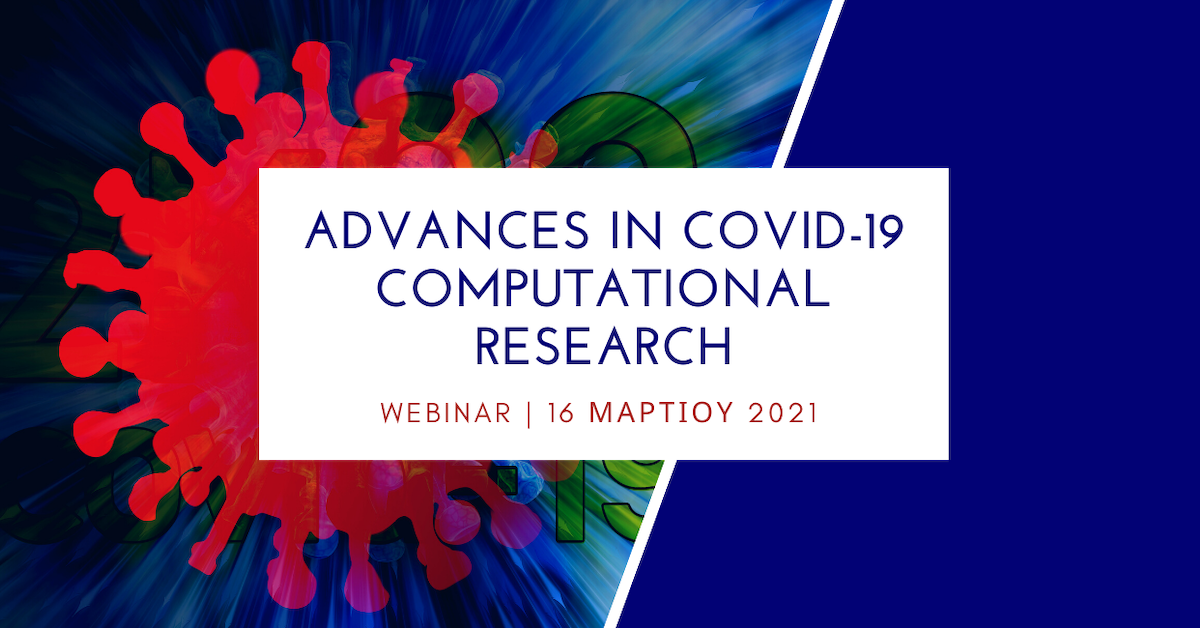Advances in COVID-19 Computational Research
Webinar | 16 March 2021 | 13:00

The webinar "Advances in COVID-19 Computational Research" is organized by the Pharma Informatics Unit, Athena RC, and will take place on Tuesday, March 16th, 2021 (12:55 pm).
In the first session, Faidon Brotzakis will talk about a strategy based on metainference cryo-electron microscopy towards the targeting of the trimeric transmembrane glycoprotein that the virus uses to recognise and bind its host cells. In the second session, Ioanna Tzoulaki will present an analysis of the diagnostic models for detecting COVID-19 and the prognostic models for predicting mortality risk and severe outcomes published to date. In the last session of the webinar Panos Macheras will focus on the reaction between susceptible and infected subjects under not well-mixed conditions in order to get insights on the COVID-19 spreading in absence/presence of preventive measures.
To participate in the event, please register here.
Program
Abstracts

Wynants L, Van Calster B, Collins GS, Riley RD, Heinze G, Schuit E, Bonten MMJ, Damen JAA, Debray TPA, De Vos M, Dhiman P, Haller MC, Harhay MO, Henckaerts L, Kreuzberger N, Lohman A, Luijken K, Ma J, Andaur CL, Reitsma JB, Sergeant JC, Shi C, Skoetz N, Smits LJM, Snell KIE, Sperrin M, Spijker R, Steyerberg EW, Tzoulaki I, Takada T, van Kuijk SMJ, van Royen FS, Wallisch C, Hooft L, Moons KGM, van Smeden M. Prediction models for diagnosis and prognosis of covid-19 infection: systematic review and critical appraisal. BMJ 2020; 369. doi: https://doi.org/10.1136/bmj.m1328

The reaction between susceptible and infected subjects has been studied under the well-mixed hypothesis for almost a century. Here, a consistent analysis for a not well-mixed system using fractal kinetics principles is presented. COVID-19 data were analyzed to get insights on the disease spreading in absence/presence of preventive measures. A three-parameter model was derived. The “fractal” exponent h of time larger than unity can capture the impact of preventive measures affecting population mobility. The h=1 case, which is a power of time model, accurately describes the situation without such measures in line with a herd immunity policy. The pandemic spread in four model countries (France, Greece, Italy and Spain) for the first 10 months has gone through 4 stages: stages 1 and 3 with limited to no measures, stages 2 and 4 with varying lockdown conditions. For each stage and country two or three model parameters have been determined using appropriate fitting procedures. The fractal kinetics model was found to be more akin to real life. Model predictions and their implications lead to the conclusion that the fractal kinetics model can be used as a prototype for the analysis of all contagious airborne pandemics.
K. Kosmidis, P. Macheras .A fractal kinetics SI model can explain the dynamics of COVID-19 epidemics. (2020) . PLoS ONE 15(8): e0237304. https://doi.org/10.1371/journal.pone.0237304
P. Macheras, K. Kosmidis, P. Chryssafidis. Demystifying the spreading of pandemics I: The fractal kinetics SI model quantifies the dynamics of COVID-19 , medRxiv 2020.11.15.20232132; doi: https://doi.org/10.1101/2020.11.15.20232132
P. Macheras, A. Tsekouras, P. Chryssafidis. Fractal kinetics: The common denominator in drug release kinetics and COVID-19 spreading. Submitted.
